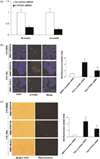Histone modification-mediated CYP2E1 gene expression and apoptosis of HepG2 cells
- PMID: 20404016
- PMCID: PMC3991239
- DOI: 10.1258/ebm.2009.009252
Histone modification-mediated CYP2E1 gene expression and apoptosis of HepG2 cells
Abstract
The incidence of hepatocellular carcinoma is rising due to alcohol drinking, hepatitis C viral infection and metabolic syndrome. Differential expression of CYP2E1 may play a pleiotropic role in the multistep process of liver carcinogenesis. Considerable attention has focused on the antitumor effect of trichostatin A (TSA) as well as CYP2E1 expression-induced apoptosis of cancer cells. However, very few studies have examined the mechanisms by which TSA has an antitumor effect and its association to CYP2E1 expression. The current study examined the action of TSA on CYP2E1 expression and the role of CYP2E1 in inducing apoptosis of HepG2 cells. Our data showed that TSA selectively induced CYP2E1 in four studied human hepatocellular carcinoma (HCC) cell lines (Huh7, PLC/PRF/5, Hep3B and HepG2), but not in normal primary human hepatocytes. TSA-mediated up-regulation of CYP2E1 expression was associated with histone H3 acetylation and the recruitment of HNF-1 and HNF-3beta to the CYP2E1 promoter in HepG2 cells. siRNA-mediated knockdown experiments showed that TSA-induced caspase-3 cleavage was decreased due to reduced expression of CYP2E1 in HepG2 cells. Moreover, down-regulation of CYP2E1 was accompanied by decreased production of mitochondrial reactive oxygen species. These results suggest that histone modification is involved in CYP2E1 gene expression and that CYP2E1-dependent mitochondrial oxidative stress plays a role in TSA-induced apoptosis.
Figures







Similar articles
-
Induction of the liver cancer-down-regulated long noncoding RNA uc002mbe.2 mediates trichostatin-induced apoptosis of liver cancer cells.Biochem Pharmacol. 2013 Jun 15;85(12):1761-9. doi: 10.1016/j.bcp.2013.04.020. Epub 2013 May 1. Biochem Pharmacol. 2013. PMID: 23643933 Free PMC article.
-
Cell growth inhibition and gene expression induced by the histone deacetylase inhibitor, trichostatin A, on human hepatoma cells.Oncology. 2004;66(6):481-91. doi: 10.1159/000079503. Oncology. 2004. PMID: 15452378
-
Histone deacetylase inhibitors induce in human hepatoma HepG2 cells acetylation of p53 and histones in correlation with apoptotic effects.Int J Oncol. 2008 Jan;32(1):177-84. doi: 10.3892/ijo.32.1.177. Int J Oncol. 2008. PMID: 18097557
-
Identification of genes up-regulated by histone deacetylase inhibition with cDNA microarray and exploration of epigenetic alterations on hepatoma cells.J Hepatol. 2004 Sep;41(3):436-45. doi: 10.1016/j.jhep.2004.05.018. J Hepatol. 2004. PMID: 15336447
-
Oxidative stress, toxicology, and pharmacology of CYP2E1.Annu Rev Pharmacol Toxicol. 2004;44:27-42. doi: 10.1146/annurev.pharmtox.44.101802.121704. Annu Rev Pharmacol Toxicol. 2004. PMID: 14744237 Review.
Cited by
-
Alcohol dehydrogenase and cytochrome P450 2E1 can be induced by long-term exposure to ethanol in cultured liver HEP-G2 cells.In Vitro Cell Dev Biol Anim. 2013 Sep;49(8):619-25. doi: 10.1007/s11626-013-9636-y. Epub 2013 Jul 4. In Vitro Cell Dev Biol Anim. 2013. PMID: 23824954
-
Induction of the liver cancer-down-regulated long noncoding RNA uc002mbe.2 mediates trichostatin-induced apoptosis of liver cancer cells.Biochem Pharmacol. 2013 Jun 15;85(12):1761-9. doi: 10.1016/j.bcp.2013.04.020. Epub 2013 May 1. Biochem Pharmacol. 2013. PMID: 23643933 Free PMC article.
-
Histone Deacetylase Expressions in Hepatocellular Carcinoma and Functional Effects of Histone Deacetylase Inhibitors on Liver Cancer Cells In Vitro.Cancers (Basel). 2019 Oct 18;11(10):1587. doi: 10.3390/cancers11101587. Cancers (Basel). 2019. PMID: 31635225 Free PMC article.
-
Epigenetic modification of histone 3 lysine 27: mediator subunit MED25 is required for the dissociation of polycomb repressive complex 2 from the promoter of cytochrome P450 2C9.J Biol Chem. 2015 Jan 23;290(4):2264-78. doi: 10.1074/jbc.M114.579474. Epub 2014 Nov 12. J Biol Chem. 2015. PMID: 25391650 Free PMC article.
-
Integrated Multiple "-omics" Data Reveal Subtypes of Hepatocellular Carcinoma.PLoS One. 2016 Nov 2;11(11):e0165457. doi: 10.1371/journal.pone.0165457. eCollection 2016. PLoS One. 2016. PMID: 27806083 Free PMC article.
References
-
- Llovet JM, Burroughs A, Bruix J. Hepatocellular carcinoma. Lancet. 2003;362:1907–1917. - PubMed
-
- El-Serag HB, Rudolph KL. Hepatocellular carcinoma: epidemiology and molecular carcinogenesis. Gastroenterology. 2007;132:2557–2576. - PubMed
-
- El-Serag HB. Hepatocellular carcinoma: recent trends in the United States. Gastroenterology. 2004;127:S27–S34. - PubMed
-
- Llovet JM. Updated treatment approach to hepatocellular carcinoma. J Gastroenterol. 2005;40:225–235. - PubMed
-
- Varela M, Bruix J. Hepatocellular carcinoma in the United States. Lessons from a population-based study in Medicare recipients. J Hepatol. 2006;44:8–10. - PubMed
Publication types
MeSH terms
Substances
Grants and funding
LinkOut - more resources
Full Text Sources
Medical
Research Materials

